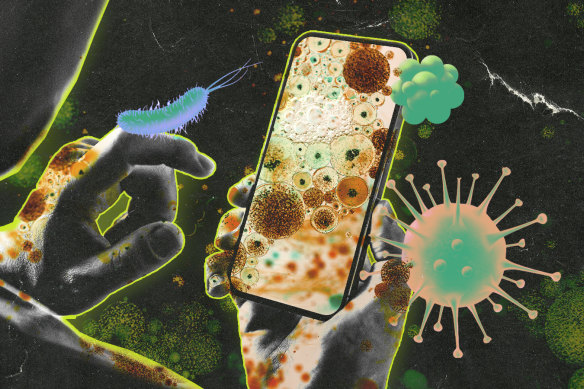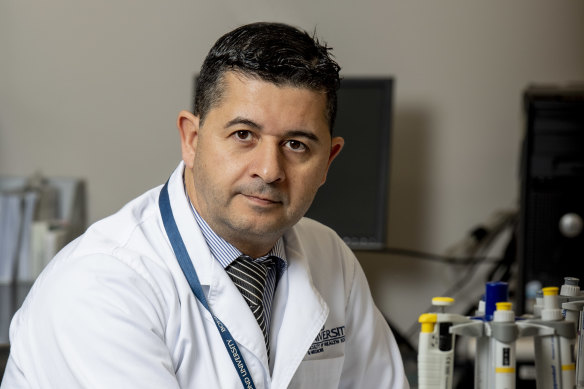By Angus Dalton
Molecular geneticist Dr Lotti Tajouri sterilises his phone five times a day, and he won’t be stopping any time soon, given recent test results.
Tajouri swabbed the phones of guests at a Sydney medical conference last year and found they were “filthy” with bacteria, viruses and fungi. Genomic testing revealed the presence of drug-resistant superbugs, dangerous pathogens, and biosecurity “red flags”, including fungi and bacteria capable of crippling crops.

Doctors visiting Sydney had their phones swabbed. The results were disgusting.Credit: Aresna Villanueva
“On 20 phones, we found 2204 microorganisms,” Tajouri, an associate professor at Bond University, said. “It really shows you the diversity that mobile phones can harbour – they can actually be the place where microbes are feeding and breeding and thriving.”
The phones belonged to attendees from almost every continent. Tajouri and his colleagues recommend in their newly published Infection, Disease & Health study that phones should be sanitised at airports to minimise the spread of superbugs and pathogens.
Microbes detected on phones included Staphylococcus aureus, the bug behind the common hospital infection golden staph, and Pantoea stewartii, a pathogen that attacks rice, corn and jackfruit crops and has also sickened critically endangered Australian parrots.
A previous systematic review by Tajouri found 45 per cent of phones tested at the height of the pandemic were positive for COVID-19.

Associate Professor Lotti Tajouri at Bond University is an expert in molecular genetics, which he used to identify 2204 microbes on 20 doctors’ phones.Credit: Bond University
“We think that mobile phones – with modern transport – actually contribute to pandemics and the dissemination of viruses, of bacteria, of superbugs around the world,” Tajouri said. “And we must act.”
Our phones teem with bugs because we keep them warm and protected in pockets, mist them with saliva during calls and periodically splatter the screen with a buffet of nutritious crumbs while eating.
They are populated with a melange of microbes from fingers and exposed to fecal matter in bathrooms.
“I consider mobile phones a five-star hotel for microorganisms,” Tajouri said. “They’re mobile petri dishes.”
In a 2021 survey of 165 healthcare workers, Tajouri found 52 per cent scrolled their phones while in the bathroom and 57 per cent never cleaned their devices.
“You can wash your hands as many times as you want, but by touching your mobile phone, which is filthy, you cross-contaminate, and you negate your washing,” he said.
Tajouri is trying to rebrand phones as a “third hand” and add an extra step to hand hygiene guidelines by urging people to sterilise their devices daily.
Tajouri uses an ethanol-based cleaner to gently wipe his screen five times a day. (Doing this too vigorously can damage the phone; he lost a previous device to overzealous cleaning.)
How to keep your phone clean
- Experts recommend cleaning your phone daily
- Use an alcohol-based wipe or spray with at least 70 per cent alcohol
- Don’t spray sanitisers directly on phone
- Unplug phone when cleaning and keep fluids away from charging port
- Touch your phone with clean hands
- Consider purchasing a UV phone sanitiser
Ultraviolet phone cleaners kill bacteria and viruses by damaging their DNA. Tajouri would like to see the devices – in which phones are inserted like a slice of bread in a toaster – installed beside cleaning stations at hospitals.
The new study estimates 750 million microbes were introduced to Australian in 2022 via the “Trojan horse” of mobile phones carried by travellers.
“Not all these microbes are harmful, of course, but the odds that pathogenic microbes may find a potential pathway of entry into Australia is high with millions of visitors,” Tajouri said.
“Imagine if you came back to Australia after travelling, and you were holding a petri dish with colonies of bacteria. The biosecurity officer would stop you straight away.”
The Examine newsletter explains and analyses science with a rigorous focus on the evidence. Sign up to get it each week.